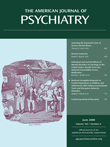Wish I Could Be There is a compelling narrative written by Allen Shawn—musician, composer, author, and professor—who focuses his life story around his own experiences with agoraphobia and panic disorder. Part emotionally raw memoir, part patient-generated explanation of the panoply of scientific, medical, psychiatric, and psychological causes of agoraphobia, the book offers a unique and thoughtful view of the centrality of one man’s crippling symptoms and his longstanding attempts to understand and alter them. The book offers some of the most clearly rendered descriptions I have ever encountered in print of the encroaching nature of severe phobias and the way they can provide the backbone to an entire personality.
This is not a treatment guide and the descriptions of treatments are cursory. The sections of text that pertain to the genetic, evolutionary, neurochemical, cognitive-behavioral, and psychoanalytic understandings of agoraphobia and panic do not largely describe state-of-the-art scientific work but rather are overviews of bodies of scientific ideas. These sections provide a thoughtful and articulate translation for a nonprofessional audience from a wide range of scientific experts that have brought their methods of investigation to bear on the problems of crippling agoraphobia. This aspect of the book serves as a nice general introduction to the disorder for the nonpsychiatric community.
However, it is the more personal aspects of this account, the deeply moving personal story of Mr. Shawn’s life and his growing emotional and psychological understanding of his anxiety, that makes this arresting reading for psychiatrists, particularly those who, like myself, spend their professional lives treating patients with anxiety disorders. In summary, Mr. Shawn links the development of his agoraphobia and panic to several converging and painful developmental emotional situations, including his parents’ rigid secrecy about his father’s longstanding, semi-public extramarital relationship, his parents’ secretive relationship with their own psychiatric illnesses and its effects on him, and, above all, his central, heartbreaking experience of having an autistic twin sister and witnessing her rarely discussed therapeutic expulsion from the family home. His writing is luminous and poetic in describing the fabric of his experiences with anxiety and the deep emotional vortex into which they pull him, linking him inexorably with his tragic, damaged twin. His musical gift is evident in his prose. He has remarkable insight and the ability to reflect meaningfully on some of the emotional underpinnings of his illness. He is prescient in his understanding about the deep connection between the fantasy nature of the phobic facade
(1), in which “a phobia can be seen as a fissure in reality” (p. 124), and areas of feeling and thought that are forbidden, for whatever reason.
Mr. Shawn collects information on agoraphobic authors throughout history, from Emily Dickenson to Charles Darwin, the way those who fear flying collect and store gruesome accounts of plane crashes. He dwells on them. The book is peppered with their quotes. This appears in part to serve the purpose of supporting Mr. Shawn’s wishful view that his phobias and accomplishments are inseparable: “were we to neutralize our suffering and inner turmoil, would we not also lose our capacity to feel things deeply and to exult?” (p. 251).
Since the advent of DSM-III in 1980, psychiatrists have had relatively stable, telegraphic clinical descriptions of panic disorder and agoraphobia that have guided research and most clinical practice. All clinicians, to a greater extent, must work to balance patients’ individual narratives with more general descriptions. DSM has brought surprising order to the cacophony of individual patient experiences, which has permitted the field to move forward across so many domains, from the development of treatment methods to multiple areas of clinical and translational research. Sadly, this order has come at the cost of the literature, which has become dry. Mr. Shawn’s book takes the reader back to an earlier time in psychiatry, when rich case descriptions were emotionally illuminating and dominated the field. It is refreshing.

